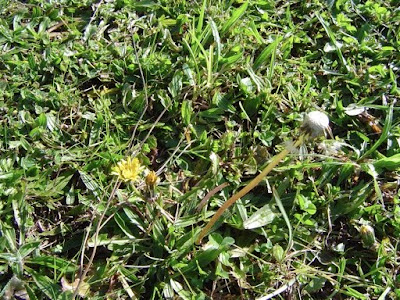This is not such a great pic of a dandelion, however it is important to note the flower is on a single stem. The leaves look very similar to hawksbeard (see below). The root can be used for coffee or as a vegetable. The leaves in salad. Wine from the flowers.
We have loads of sheep sorrel in our garden. I cursed it until I tried eating the leaves. Now it's a best friend. Great in salads or soup. Normally grows in the garden where the soil is a tad acid.
Sheep sorrel (rumex)
Often feared as they are confused with deadly nightshade, but this black nightshade is very good eating. Cook leaves as a vegetable. Berries are good raw or cooked.
Mainly used as a medicinal plant although groundsel can be eaten too. Leaves cooked as a vegetable. The young leaves have been used in salad, though inadvisable since the plant is a cumulative toxin. It is often used as a poultice and is said to be useful in treating sickness of the stomach, whilst a weak infusion is used as a simple and easy purgative. NB I fried some falafel and added some groundsel leaf, stem and flower heads right at the end. I threw in a pinch of salt. Amazing result! In fact I preferred the groundsel quickly fried to the falafel.

Groundsel (senecio vulgaris)
Known as soursob, shamrock, wood sorrel or oxalis the leaves, flowers and roots can be added to salads. Oxalis contains Oxalic Acid, so should be eaten in moderation. The flowers are delicious.

Wood sorrel (oxalis)
This bitter wild lettuce is like cos. Eat young leaves raw, older leaves in soup/smoothies.
Wild roses or briars make ripe rosehips in the winter well after the petals have dropped. You can add ripe rosehips to stews and soups. Boil and strain to make a sauce. Boil to make a health giving tea. Rose hip tea is refreshing, pleasantly tart and contains vitamins A, B, C, E and K, pectin and organic acids. Besides battling colds, the nutrient rich tea boosts your health in other ways as well; it helps strengthen the body's resistance to infection, reinforces digestive function, combats all kinds of illness with fever, flushes out the kidneys and urinary tract and relieves mild rheumatic pain.
The leaves of storksbill can be cooked as vegetable, but the entire plant is edible with a flavor similar to parsley if picked young.
A primitive sage, lyreleaf sage or wild sage is not medicinal, but the fruit can be eaten. Apparently it makes a good incense.
You can soak fumitory in cold water and wash face as a tonic and cleanser.
Young leaves of acanthus can be eaten. The flowers and fruits (cheeses) can be cooked as vegetable.



Acanthus (acantha)
Sow thistles are bitter but very nutritional. All aerial parts can be eaten. Young leaves in salad; cooked greens.

Sow thistle (sonchus)
Slightly slimy mallows are soothing medicinally. Roots can make a healthy tonic tea. Young leaves can be eaten raw; flowers and fruits (cheeses) can be cooked as vegetables.

Wild fennel (apiaceae)

Flatweed (hypochaeris radicata)

Dock weed (rumex)

Hawksbeard (crepis)

Milkweed (silybum adans)

Wild radish (raphanus raphanistrum)
Plantains can be be used for salads and soups, but only very young leaves. Also have medicinal properties.

Plantain (plantago)
As you can see, I still have to complete my notes, and I will add to them over time, especially notes on application (cooking) of weeds.
And these are two that should never be eaten:




















1 comment:
I'm inspired by all these creative ways to use edible weeds.
Post a Comment